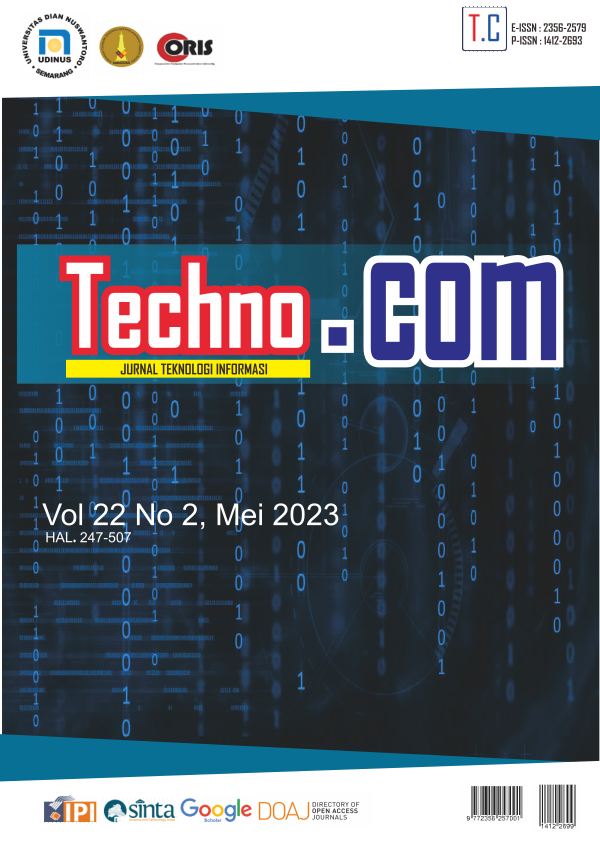Penerapan Flower Pollination Algorithm dengan Teknik Clustering dalam Penyelesaian Masalah Diophantine
DOI:
https://doi.org/10.33633/tc.v22i2.7174Keywords:
Flower Pollination Algorithm, Clustering technique, The Diophantine ProblemAbstract
Permasalahan Diophantine adalah suatu permasalahan yang diwakili persamaan atau sistem persamaan yang memerlukan bilangan bulat non-negatif sebagai solusi. Permasalahan ini banyak dijumpai di berbagai bidang termasuk Computer engineering seperti pengelolaan jaringan dan sinyal. Akan tetapi belum ada metode umum yang secara efektif dapat menyelesaikan permasalahan Diophantine. Tujuan utama dalam penelitian ini adalah untuk melakukan penyesuaian metode FPAC agar FPAC tidak hanya dapat digunakan pada permasalahan Multimodal tetapi juga dapat dijadikan sebagai alternatif pada permasalahaan Diophantine. Transformasi persamaan ataupun sistem persamaan ke dalam bentuk fungsi optimasi dan transformasi output bilangan real ke bilangan bulat pada setiap tahapan algoritma merupakan kunci utama FPAC dalam menyelesaikan permasalahan Diophantine. Hasil penelitian ini menunjukan bahwa FPAC dapat menemukan seluruh solusi dari persamaan Diophantine baik persamaan yang memiliki jumlah variabel dan pangkat yang berbeda maupun persamaan dalam bentuk eksponensial. FPAC juga dapat menemukan seluruh solusi yang tersedia pada sistem persamaan Diophantine baik yang berdimensi rendah (kasus 1) maupun dimensi tinggi (kasus 2 dan 3). Secara umum, FPAC terbukti efektif dalam menyelesaikan permasalahan Diophantine baik dalam bentuk persamaan maupun sistem persamaan yang memiliki solusi tunggal maupun jamak dalam sekali running.References
I. Agmour, M. Bentounsi, N. Achtaich, and Y. El Foutayeni, “Bifurcation and stability of a dynamical system with threshold prey harvesting,” Int. J. Comput. Sci. Math., vol. 14, no. 1, pp. 36–53, 2021.
V. O. Osipyan, K. I. Litvinov, R. K. Bagdasaryan, E. P. Lukashchik, S. G. Sinitsa, and A. S. Zhuk, “Development of information security system mathematical models by the solutions of the multigrade diophantine equation systems,” ACM Int. Conf. Proceeding Ser., pp. 1–8, 2019, doi: 10.1145/3357613.3357624.
M. R. Nasiri, S. Farhangi, and J. Rodriguez, “Model Predictive Control of a Multilevel CHB STATCOM in Wind Farm Application Using Diophantine Equations,” IEEE Trans. Ind. Electron., vol. 66, no. 2, pp. 1213–1223, 2019, doi: 10.1109/TIE.2018.2833055.
R. Radha and G. Janaki, “Applications Of Diophantine Equations In Chemical Reactions And Cryptography,” vol. 12, no. 7, pp. 3175–3178, 2021.
O. Pérez, I. Amaya, and R. Correa, “Numerical solution of certain exponential and non-linear Diophantine systems of equations by using a discrete particle swarm optimization algorithm,” Appl. Math. Comput., vol. 225, pp. 737–746, 2013, doi: 10.1016/j.amc.2013.10.007.
S. Abraham, S. Sanyal, and M. Sanglikar, “Finding numerical solutions of diophantine equations using ant colony optimization,” Appl. Math. Comput., vol. 219, no. 24, pp. 11376–11387, 2013, doi: 10.1016/j.amc.2013.05.051.
D. Zaitsev, S. Tomov, and J. Dongarra, “Solving linear diophantine systems on parallel architectures,” IEEE Trans. Parallel Distrib. Syst., vol. 30, no. 5, pp. 1158–1169, 2018, doi: 10.1109/TPDS.2018.2873354.
Y. Man, “A Top-down Approach for Solving Linear Diophantine Equation,” in Lecture Notes in Engineering and Computer Science: Proceedings of the World Congress on Engineering, 2019, vol. 0958, pp. 5–7.
Z. A. A. Alyasseri, A. T. Khader, M. A. Al-Betar, and O. A. Alomari, “Person identification using EEG channel selection with hybrid flower pollination algorithm,” Pattern Recognit., vol. 105, p. 107393, 2020, doi: 10.1016/j.patcog.2020.107393.
P. Singh and N. Mittal, “An efficient localization approach to locate sensor nodes in 3D wireless sensor networks using adaptive flower pollination algorithm,” Wirel. Networks, vol. 27, no. 3, pp. 1999–2014, 2021, doi: 10.1007/s11276-021-02557-7.
F. B. Ozsoydan and A. Baykasoglu, “Chaos and intensification enhanced flower pollination algorithm to solve mechanical design and unconstrained function optimization problems,” Expert Syst. Appl., vol. 184, no. May, p. 115496, 2021, doi: 10.1016/j.eswa.2021.115496.
R. Karim, K. A. Sidarto, and S. Bantun, “Optimasi Fungsi Multimodal Menggunakan Flower Pollination Algorithm Dengan Teknik Clustering,” Techno.Com, vol. 19, no. 2, pp. 124–134, 2020, doi: 10.33633/tc.v19i2.3216.
X.-S. Yang, Nature-Inspired Optimization Algorithms, Second. Academic Press, 2021.
V. Aggarwal, “Solving transcendental equations using Genetic Algorithms,” pp. 1–12, 2000.
S. Katoch, S. S. Chauhan, and V. Kumar, A review on genetic algorithm: past, present, and future, vol. 80, no. 5. Multimedia Tools and Applications, 2021.
X. Li, M. G. Epitropakis, K. Deb, and A. Engelbrecht, “Seeking Multiple Solutions: An Updated Survey on Niching Methods and Their Applications,” IEEE Trans. Evol. Comput., vol. 21, no. 4, pp. 518–538, 2017, doi: 10.1109/TEVC.2016.2638437.
K. A. Sidarto, A. Kania, and N. Sumarti, “Finding multiple solutions of multimodal optimization using spiral optimization algorithm with clustering,” Mendel, vol. 23, no. 1, pp. 95–102, 2017, doi: 10.13164/mendel.2017.1.095.
Downloads
Published
Issue
Section
License
License Terms
All articles published in Techno.COM Journal are licensed under the Creative Commons Attribution-NonCommercial 4.0 International (CC BY-NC 4.0). This means:
1. Attribution
Readers and users are free to:
-
Share – Copy and redistribute the material in any medium or format.
-
Adapt – Remix, transform, and build upon the material.
As long as proper credit is given to the original work by citing the author(s) and the journal.
2. Non-Commercial Use
-
The material cannot be used for commercial purposes.
-
Commercial use includes selling the content, using it in commercial advertising, or integrating it into products/services for profit.
3. Rights of Authors
-
Authors retain copyright and grant Techno.COM Journal the right to publish the article.
-
Authors can distribute their work (e.g., in institutional repositories or personal websites) with proper acknowledgment of the journal.
4. No Additional Restrictions
-
The journal cannot apply legal terms or technological measures that restrict others from using the material in ways allowed by the license.
5. Disclaimer
-
The journal is not responsible for how the published content is used by third parties.
-
The opinions expressed in the articles are solely those of the authors.
For more details, visit the Creative Commons License Page:
? https://creativecommons.org/licenses/by-nc/4.0/
















